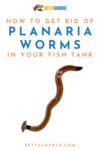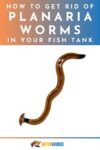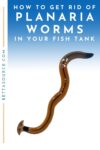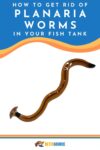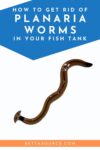No one wants to find tiny creepy worms wriggling around in their fish tank. Yuk!
If you spot a mass of tiny, stringy white worms living in the substrate, those are most likely detritus worms.
These creatures feed on uneaten food, fish waste, and general detritus in your tank, hence the worms’ name. These worms are usually a sign of a dirty tank!
However, in this article, we’re taking a look at another common species of pesky aquarium worms called planaria that you sometimes find in your betta tank.
What Are Planaria Worms?
Planaria belong to the ancient Platyhelminth phylum group of flatworms and are related to other similar creatures, such as liver flukes.
Planaria can be found in saltwater and freshwater fish tanks worldwide, finding their way into your aquarium hidden in plants, rocks, substrate, and even attached to fish.
These fast-breeding worms are hermaphrodites, meaning they don’t need males and females to reproduce.
Did you know that if you chop up a planarian worm into half a dozen pieces, you’ll have half a dozen fully-formed flatworms within a few days?
Most species of planaria graze on waste products in the substrate, although some are parasitic or predatory. These worms are deceptively advanced and can detect water currents through sensory apparatus in their heads and eyes.
Planaria generally shy away from the light, preferring darker conditions and coming out mostly at night, which can make them difficult to spot. They can hide in and amongst plants, rock crevices, and substrate.
How To Identify Planaria Worms
Before treating the worms in your aquarium, you need to identify the species positively. Planarian worms are around 10 millimeters long with flat bodies.
The creatures have a triangular head with two tiny eyes that are visible, and the worms can be white, brown, grey, or even pinkish in color, depending on what food they have been eating.
You will likely spot these wrigglers sliding across your aquarium glass rather than living on the substrate. However, sometimes you might spot a worm attached to your poor betta or one of your other aquarium inhabitants, almost as though they were some expert hitchhiker.
Are Planaria Worms Dangerous to Your Fish?
Planaria worms do not generally harm healthy fish. However, they love to feed on fish eggs, which is a big problem if you keep egglaying fish along with your betta.
Some species of predatory, carnivorous planaria also attack the eyes and gills of weakened adult fish.
These creatures come in two broad types; those that eat detritus and those that are predatory.
Are Planaria Worms Harmful to Humans?
No. Planaria worms are not harmful to humans if they touch your skin. They’re mostly just a threat to some aquatic species.
That being said, it’s best to handle them with caution. Wearing gloves whilst dealing with them and taking care to remove them thoroughly is the best course of action.
Some people have reported possible allergic reactions to planaria worms, so handle them cautiously.
How To Prevent a Planaria Infestation
If you’ve had to deal with them already, you’ll likely want to know the best action to prevent another infestation. The best way to do this is by re-evaluating your aquarium cleaning routine.
It can be a bit time-consuming, but siphoning the bottom of your aquarium should be part of your weekly water changes as this can prevent the build-up of uneaten food.
You should be careful when siphoning your tank; it is recommended not to do this all at once. Instead, split your tank into sections and do one section per week.
Siphoning the whole bottom of the aquarium every week can lead to spikes in ammonia levels if too much debris is disrupted at once.
Dugesia Planaria Worms
Dugesia planaria worms are black and brown. These creatures are harmless to fish. However, they feed on detritus, including faeces, biofilm, and uneaten food.
If you have a population of these planaria in your tank, that’s an indication of poor aquarium husbandry. If you have a very dirty tank, you could potentially finish up with hundreds or even thousands of these worms.
Although Dugesia planaria worms aren’t carnivorous, they can slide into the gills and other sensitive areas of fish, causing stress that weakens the fish’s immune system and leaving the victims vulnerable to disease.
However, these worms can be a big problem if you have shrimp in your setup. This species of planarians are thought to secrete a toxin that can poison invertebrates.
So, if one of these worms slithers inside a shrimp carapace, toxins could be deposited directly into the unfortunate shrimp’s tissues as they are known to do.
Procotyla Fluviatillis
White planarians are classified as Procotyla fluviatillis. These critters are fiercely predatory, eating small worms, crustaceans, daphnia, and other planaria.
Procotyla will attack anything small that comes within reach, so shrimp keepers, beware!
Procotyla’s most common victims include shrimp eggs, baby shrimp, and adult shrimps – basically anything in a shrimp tank!
Although they typically occur in fewer numbers than Dugesia planaria, these pesky critters can still damage the peaceful shrimp and crustaceans living in your tank.
How To Get Rid of Planaria Worms
So, you can see that you really don’t want an infestation of planaria worms in your tank. Unfortunately, both types of these persistent pests are extremely resilient and can be incredibly challenging to eradicate.
Emptying the whole tank and starting over won’t shift the worms. They will simply reappear and quickly multiply to reinfest your aquarium.
Changing the water temperature doesn’t work either. In fact, research has shown that planarians can survive in refrigerated conditions with no food at all!
Copper Treatments
Copper treatments can be effective against planaria worms, but they will also harm shrimps and snails.
However, if you don’t have invertebrates in your community, dosing the tank with a copper-based medication could do the trick.
As with any chemical treatment, read and follow the manufacturer’s directions carefully and never exceed the recommended dose.
Betel Nut Palm Extract
Betel nut palm extract is a herbal treatment that is highly effective against planaria and will get rid of the worms without harming your shrimp and fish.
You’ll find betel nut palm extract as the active ingredient of a herbal product called No Planaria, which you can buy online at this link.
Remember that you will need to give your aquarium a thorough overhaul and a deep clean with an aquarium vacuum cleaner to get rid of all the dead and dying worms once the treatment has concluded.
Chemical Worm Treatments
Because planaria problems can be caused by just a few worms that are tricky to spot, getting rid of them is tricky. For that reason, chemical treatments are usually the preferred method of eradicating these pests.
However, chemicals can be very harmful to fish, plants, and invertebrates, so you must be absolutely certain that planaria are the problem.
If you’re in any doubt, capture a couple of the worms in a planaria trap and ask your local fish store or veterinary practice to confirm the species of parasite you’re dealing with.
Aquarium Supplies ISTA Clear Glass Planaria Trap for Cherry Shrimp Crystal Red Shrimp Dwarf Shrimp
- Clear GLASS Dish.
- Planaria trap comes with 3 holes design which is able to trap planaria efficiently to reduce the planaria population in the tank. Planaria trapped inside the tube will never be able to come out from the designed hole. Trap/Catches Planaria, Flat Worms, and Leeches.
- Equally effective for leeches
Once you know that you definitely have planaria worms in your tank, it’s vital that you thoroughly research the chemical product that you use to make sure it’s safe for your fish and other livestock.
In particular, remove invertebrates from the tank before you treat the water. Also, some bottom feeders, scaleless or Metynnis fish species, may be highly sensitive to worm eradication treatments, so we recommend removing these fish from your tank before treatment.
Always follow the manufacturer’s guidelines when using chemical treatments in your tank, as overdosing could kill your fish. Be sure to wear gloves when handling chemicals for your personal safety.
The most effective chemicals for treating planaria worms contain Trichlorfon, a powerful neurotoxin. However, we recommend you ask for advice from your vet or local fish store when choosing a treatment for your fish tank.
Treating Sensitive Fish
As mentioned, it’s potentially very dangerous to use chemical treatments in a betta tank containing sensitive fish species. You should remove and rehouse them temporarily until the main aquarium has been treated.
But what do you do if a sensitive fish or your betta has one of these fluke worms attached to it?
The easiest way to remove the worm is to treat the fish with a quick saltwater dip or bath. Read this detailed guide to learn more about giving your betta fish a salt bath or dip.
Before returning the fish to the quarantine or main tank, take a pair of blunt tweezers and gently remove the weakened worm from the fish’s body.
In Conclusion
Planaria worms can be a real nuisance in your fish tank, especially if you keep shrimp. To effectively get rid of the worms, you’ll need to use a chemical treatment, but be sure to remove any sensitive species of fish first.
Once treatment is complete, give your tank a thorough deep clean by vacuuming the substrate.
In the future, be sure to keep your aquarium clean and free from fish waste, leftover food, and general detritus that can provide food for the worms.

